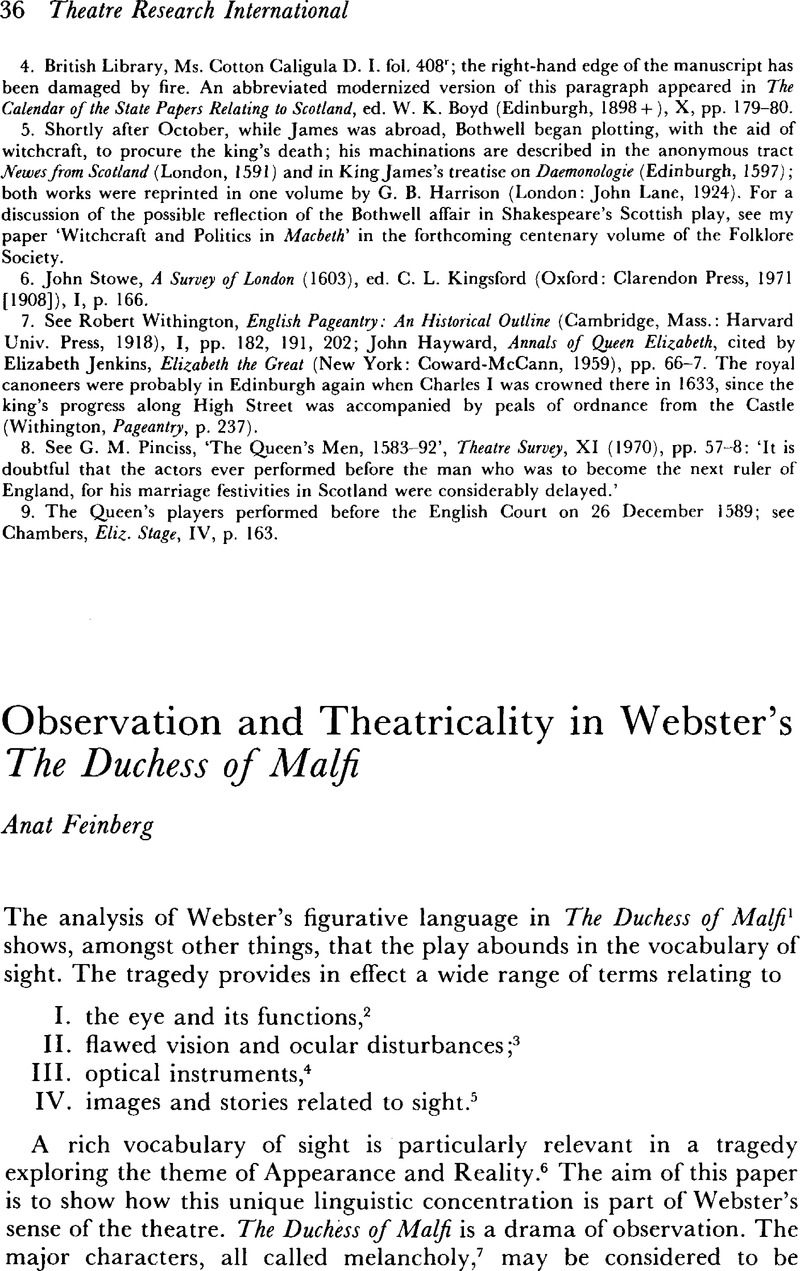No CrossRef data available.
Published online by Cambridge University Press: 23 January 2009

1. For detailed discussions of Webster's imagery see Stagg, Louis Charles, An Index to the Figurative Language of John Webster (Charlottesville, Va., 1967)Google Scholar; Price, Hereward T., ‘The Function of Imagery in Webster’, PMLA LXX (1955), pp. 717–39CrossRefGoogle Scholar; Sternlicht, Sanford V., John Webster's Imagery and the Webster Canon (Salzburg, 1972)Google Scholar; Damisch, Isabel M., Les Images Chez John Webster, 2 vols. (Salzburg, 1977)Google Scholar; McLeod, Susan H., Dramatic Imagery in the Plays of John Webster (Salzburg, 1977)Google Scholar; and, Goodwyn, Floyd L. Jr., Image Pattern and Moral Vision in John Webster (Salzburg, 1977).Google Scholar
2. e.g. look, observe, perceive, see, behold, etc. For further references see Corballis, R. and Harding, J. M., A Concordance To The Works of John Webster (Salzburg, 1978–1979).Google Scholar
3. e.g. blindness, dazzle, blear-eyed, blood-shot eye, sore eyes, etc. See Concordance.
4. e.g. glass, looking glass, perspective, spectacles, that fantastic glass invented by Galileo the Florentine (II, iv, 16–17) etc. See Concordance.
5. e.g. basilisk eyes, Paris's blindness (III, ii, 36–7), Reputation become invisible (III, ii, 134–5), etc. See Concordance.
6. For elucidations and discussions of this motif see, for example, Boklund, Gunar, The Duchess of Malfi: Sources, Themes, Characters (Cambridge, Mass., 1962)CrossRefGoogle Scholar; Murray, Peter, A Study of John Webster (The Hague, 1969)CrossRefGoogle Scholar; Berry, Ralph, The Art of John Webster (Oxford, 1972).Google Scholar
7. Lyons, Bridget Gellert, Voice of Melancholy (London, 1971), p. 47.Google Scholar
8. All references and quotations are taken from John Russell Brown's edition of Webster, 's The Duchess of Malfi (London, 1969).Google Scholar
9. Davies, John of Hereford, , Microcosmos, The Collected Works, ed. Grosart, Alexander B. (Edinburgh, 1878), Vol. I, Pt. iii, p. 65.Google Scholar
10. If marriage per verba de presenti was a legal custom even before the official church blessing was given, then the Cardinal has violated the law. The second pilgrim tells us that the Cardinal took off his sister's wedding ring with violence. This act symbolically violates the legitimacy of her first marriage. (See also I, i, 405–7).
11. See, for example, Thayer, C. G., ‘The Ambiguity of Bosola’, SP (1957), LIV, pp. 162–71Google Scholar; Lyons, B. G., Voices of Melancholy, p. 43Google Scholar; Berry, Ralph, The Art of John Webster, pp. 138–46.Google Scholar
12. See DM, III, iii, 41–7. Ralph Berry rightly points out that Padua, Galileo's university, was among the most highly esteemed universities in Europe. The Art of John Webster, p. 133.
13. A discussion of the melancholy scholar is available in Babb, Lawrence, The Elizabethan Malady (1951; rpt. East Lansing, 1965) pp. 96–100Google Scholar. See also, Lyons, Bridget G., Voices of Melancholy, pp. 26–7.Google Scholar
14. The title-page of the 1623 edition attests to performances in more than one type of theatre: ‘As it was Presented privately, at the Black–/Friers; and, publiquely at the Globe, By the/Kings Majesties Seruants’.
15. Berry, Ralph, The Art of John Webster, p. 141.Google Scholar
16. ibid., p. 144.
17. Inga Stina Ekeblad has convincingly argued that the eight madmen form an antimasque. ‘The Impure Art of John Webster’, RES (1958) IX, pp. 253–67.Google Scholar
18. For further instances see A Concordance To the Works of John Webster, vol. I, Pt. 4, pp. 515–16.Google Scholar
19. John Russell Brown, Introduction to Webster's The Duchess of Malfi, p. li.
20. For further references to fear see A Concordance To the Works of John Webster, vol. I, Pt. 3; pity, see vol. II, Pt. 3.
21. House, Humphry, Aristotle's Poetics (London, 1956), p. 101.Google Scholar
22. ibid., p. 101.